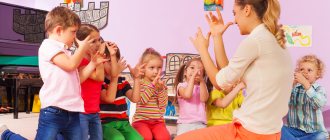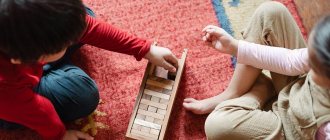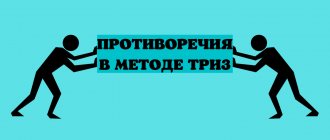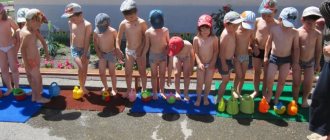Currently, preschool educational institutions are faced with the urgent question of ways to improve work to improve health and develop movements. In recent years, the health status of children has been progressively deteriorating. Currently, many children already at preschool age have problems with the musculoskeletal system. Most of these children are sedentary or, conversely, overactive. They are distinguished by an unstable psyche and undeveloped self-regulation processes. They often get sick, have a low level of physical development and, as a result, weak musculo-ligamentous apparatus.
New approaches to the content of physical education classes help improve the health level of modern preschoolers. Therefore, our teachers use new approaches to organizing physical exercise classes in their work. Modern physical education in a preschool institution should prevent diseases, that is, be preventative. In classes with weakened children, preventive physical education programs should be used. We see this solution in the organization of fitball-gymnastics in preschool educational institutions. Fitballs (from the English Fitball; fit - health improvement, ball - ball) are a large ball with a diameter of 45cm - 70cm.
The use of fitballs in our preschool educational institution allows us to solve many health problems.
The training program on such balls is unique in its effect on the body of those involved. The main goal of the exercises is to strengthen the musculoskeletal system, create a muscular corset, improve mobility in the joints, and create optimal conditions for the development of the child’s intellectual, emotional and volitional sphere. When performing physical exercises on balls, the motor, vestibular, visual and tactile analyzers are simultaneously turned on, which exponentially enhances the positive effect of the exercise.
Classes on fitballs in our preschool educational institution begin at 4-5 years of age. At the first lesson, children have the opportunity to get acquainted with new equipment. To do this, children need to be given the opportunity to play with the ball on their own. In this case, it is better to choose balls of large diameter so that the child cannot climb on it and fall. At the next stage, we need to teach children to sit down and maintain balance on the ball. It is advisable to do this separately with each child, insuring him from the side or from behind. When landing on the ball, the angle between your shin and thigh should be 90 degrees.
There are average optimal ball sizes for preschool children: 4-5 years old - 45cm; 5-6 years – 50cm; 6-7 years – 55cm.
The ball is multifunctional in its properties and can be used in fitball aerobics programs as an object, exercise machine or support.
The effectiveness of fitball gymnastics depends on the correct selection of teaching methods and techniques. In early preschool age, when teaching physical exercises, demonstration, imitations, visual, and sound cues are used to a greater extent.
Demonstration is used when children are introduced to new movements that are demonstrated several times. The technique of imitating the actions of animals or phenomena of nature and social life is very helpful in teaching children physical exercise. Imitating, for example, the actions of a bunny, children get into character and jump on fitballs with great pleasure. The positive emotions that arise in this case encourage you to repeat the same movement many times, help to consolidate a motor skill, improve its quality, and develop endurance. Visual references help children clarify directions of movement and diversify their activities. Sound cues are used to master the rhythm and regulate the tempo of movements on the fitball, and also as a signal for the beginning and end of an action, for emotional uplift. Musical accompaniment on a piano or audio recording, beating a tambourine, clapping hands, etc. are used as sound references.
Individual assistance in teaching physical exercises is used to clarify the fit on the fitball, to create the correct muscle sensations, to create confidence and success.
At an older age, with the expansion of children's motor experience, the role of verbal techniques without accompanying demonstration increases; more complex visual aids are used to clarify the construction in the form of a diagram or photograph.
In order to consolidate motor skills, exercises on a fitball should be carried out in game and competitive forms. As a result, a special physiological and emotional background arises, which enhances the impact of exercise on the body and promotes the manifestation of maximum functionality and mental strength. At the same time, higher demands are placed on physical, moral and volitional qualities (decisiveness, honesty, nobility, etc.). Those exercising with fitballs should be at a distance of 1-1.5 m from each other and from protruding objects in the hall. When performing exercises in combination with oscillatory swings on a fitball, it is necessary to control constant contact with the surface of the fitball. The pace and duration of exercises are individual for each child.
Sets of exercises on balls, depending on the tasks set and the choice of means, can have different directions:
- to strengthen the muscles of the arms and shoulder girdle, abdominals,
- to strengthen the muscles of the back and pelvis, muscles of the legs and arch of the foot,
- to increase flexibility and mobility of joints,
- for the development of balance and vestibular function,
- to develop dexterity and coordination of movements,
- for the development of plasticity and musicality,
- for relaxation and relaxation, etc.
Corrective and recreational gymnastics on balls has its own structure:
1 . The preparatory part is warming up the body and creating a positive emotional mood. It is carried out without balls and includes various types of walking, running and musical rhythmic movements.
Fitball for children
In pediatric practice, exercises on fitballs are even used to treat infants in their first year of life. They are indicated for children with diseases of the nervous system and musculoskeletal system. Classes are conducted with the help of an instructor or parents who hold the child by the arms or legs and roll him on the ball in a certain way. Such training is carried out daily or every other day.
Peculiarities!
Training with the use of a correction ball is safe from a technical point of view, since it is made of a very strong elastic material - ledraplastic. Even with mechanical damage, the fitball will not burst, but will slowly deflate without injuring the child.
At an older age, children do fitball aerobics themselves under the guidance of adults. Such exercises are even included in the curriculum for preschoolers in some kindergartens. Training takes place in a playful way in order to interest children and instill in them a love of physical education.
Fitball gymnastics is necessary not only for children with health problems, but also for absolutely healthy children, in order to take care of their harmonious physical development.
Preschoolers and schoolchildren
Fitball for preschoolers and schoolchildren is no less important. This simplest tool will help distract children from computers and gadgets, on which modern children spend a lot of time. Here are some exercises you can offer children:
- lifting the ball over your head;
- throwing a ball to coordinate hand movements;
- squats with a ball;
- throwing the ball to the parent;
- rolls on a fitball on the back;
- maintaining balance while sitting on the ball;
- bridge on the ball.
When choosing a fitball for preschoolers and schoolchildren, it is better to focus on large balls - this makes it more convenient for children to practice on them. It’s good if the fitball has a handle - it’s very convenient for many exercises, and it’s easier to carry a large ball. When buying a fitball, be guided by the child’s weight, but current manufacturers make excellent, strong balls that have been tested in production. This type of fitness equipment will not harm your health and will help diversify your child’s leisure time.
Methods of working with correction balls or fitballs
Different preschool educational institutions have different approaches to organizing fitball aerobics. In some kindergartens, this method is used as independent training 1-2 times a week. In others - as an element of dancing, free creative activity of children.
The training program with correction balls includes 4 areas:
- Fitball gymnastics is a general developmental technology that includes dynamic exercises and stretching tasks.
- Fitball rhythmics includes dance rhythmic elements.
- Fitball-athletics involves strength training, due to which different muscle groups develop.
- The fitball game consists of game tasks, competitions, and relay races.
Rhythm and athletics are mainly designed for children of primary school age. In kindergartens, only individual elements are usually used, and the main emphasis is on gymnastic and play forms.
Fitball-gymnastics solves health-improving, educational and educational problems
Training using a gymnastic ball not only helps strengthen the body and develop the musculoskeletal system. Thanks to game sets of exercises, you can develop the creative direction of a child’s personality. The classes use fairy tales, entertaining stories from the lives of favorite heroes, cartoons and book characters. This helps develop imagination and imaginative thinking.
Background music teaches children to move to the beat of the music, creates the right mood, and increases physical and emotional activity.
If the training is based on a fairy tale with an instructive plot, then it has an additional educational function, allowing children to understand how to act in certain situations from the standpoint of morality and ethics.
Organizational and methodological instructions for exercises on fitballs
Exercises on gymnastic balls take place in 4 stages:
- First, exercises on fitballs are given in combination with classical aerobics. The training includes 5-6 exercises using balls. At first, children need backup because they are not always able to stay on the ball.
- Then the emphasis is placed on the correct execution of tasks, physiological sitting on the ball, and maintaining balance. Gymnastics elements are performed sitting or lying on a fitball. Particular attention is paid to relaxation exercises.
- At this stage, the main task is to increase the pace so that all children learn to perform the exercises synchronously. Additionally, stretching tasks are introduced.
- After the basic program has been mastered, you can improve the technique of performing gymnastic elements and gradually complicate them.
It is advisable to practice fitball with children not only in kindergartens, but also at home. A gymnastic ball will be a useful acquisition not only for a child, but also for the whole family, since fitball aerobics has virtually no contraindications, and physical education is important at any age.
Fitball gymnastics in kindergarten: sets of exercises
The listed exercises are either used as independent fitness training, or are part of gaming activities, woven into a fairy-tale plot or relay competitions. Each task is repeated 3-8 times. The total duration of the workout should not exceed 30 minutes.
- Sitting on the ball, we perform smooth turns and tilts of the head in different directions.
- In the previous position, we tilt the body alternately forward - back, right - left.
- In a sitting position, place your palms on your waist and rotate your body forward and backward. The pelvis and legs remain motionless.
- Rotate with straightened arms at the shoulder joints. First forward, then back.
- We walk in different directions without lifting our buttocks from the surface of the ball.
- We jump while sitting on a fitball, first in place, then around our axis.
- We place our arms to the sides, lift our legs off the floor, and press them to the ball. Maintain balance for at least 7-10 seconds.
- We stand on the floor and take the ball with our palms. We lift it up to the right, lower it down to the left, and vice versa.
- We throw the fitball up and catch it. Children can throw the ball in pairs.
- We stand on one leg, with the other we roll a gymnastic ball along the floor forward, backward, clockwise and counterclockwise. Then we change the leg.
- We stand in front of the fitball, place our hands on it, legs straight. We roll the ball away from ourselves as far as possible, and then return it back. The legs remain straight, only the back bends.
- We lie on our backs, grab the fitball with our shins and lift it up, straightening our legs.
- In the previous position, place your bent legs on the ball so that your shins are parallel to the floor. Leaning your feet on the fitball and your shoulder blades on the floor, lift your pelvis upward.
- We lie with our chest and stomach on the ball. Feet rest on the floor. We spread our arms to the sides, raise our torso higher above the surface of the fitball.
- In the same position, we lift our feet off the floor and rest on our palms. First, alternately, and then simultaneously bend and straighten your legs at the knees.
- We turn over on the ball onto our back. Feet are on the floor. Bend and straighten your legs and roll your back over the ball.
You can complete the set of exercises with outdoor games with a fitball.




